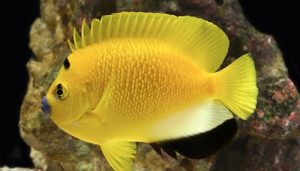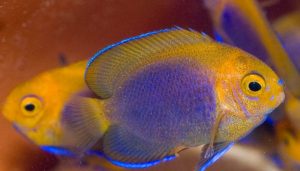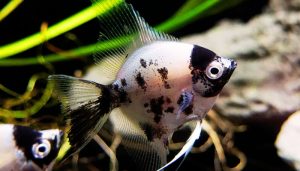Are your red cherry shrimp thriving or just surviving? One of the key factors in their health and vibrancy lies in maintaining the right red cherry shrimp water parameters.
These little gems of the aquatic world flourish when their environment mimics their natural habitat, requiring stable water conditions.
Ideal parameters include a temperature range of 72–78°F (22–26°C), a pH level between 6.5 and 8.0, and water hardness around 4–8 dKH.
Additionally, keeping ammonia and nitrite levels at zero while maintaining nitrates under 20 ppm ensures a safe and clean environment.
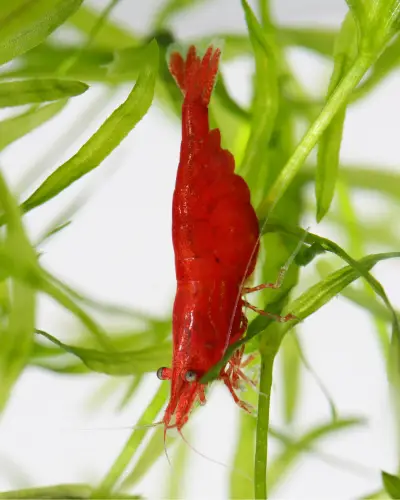
Curious about how to achieve this balance and why it matters so much? In this article, we’ll dive into everything you need to know to provide the perfect aquatic home for your red cherry shrimp.
From tips on maintaining consistent water quality to troubleshooting common issues, we’ve got you covered. Let’s explore how small changes in your tank setup can make a big difference in the health and happiness of these beautiful shrimp!
Table of Contents
ToggleThe Ideal Red Cherry Shrimp Water Parameters
The ideal water parameters for red cherry shrimp are critical to their health and well-being. These shrimp thrive in a wide range of parameters; however, certain conditions are preferable.
A general hardness (GH) of at least 6-8 dGH and a carbonate hardness (KH) of 2-4 dKH are recommended. The pH level should ideally be between 6.5 and 8.0.
Additionally, keeping the total dissolved solids (TDS) around 150-250 ppm helps maintain a stable environment. Regular water changes are vital to keep nitrate levels low, as high nitrate can adversely affect shrimp health.
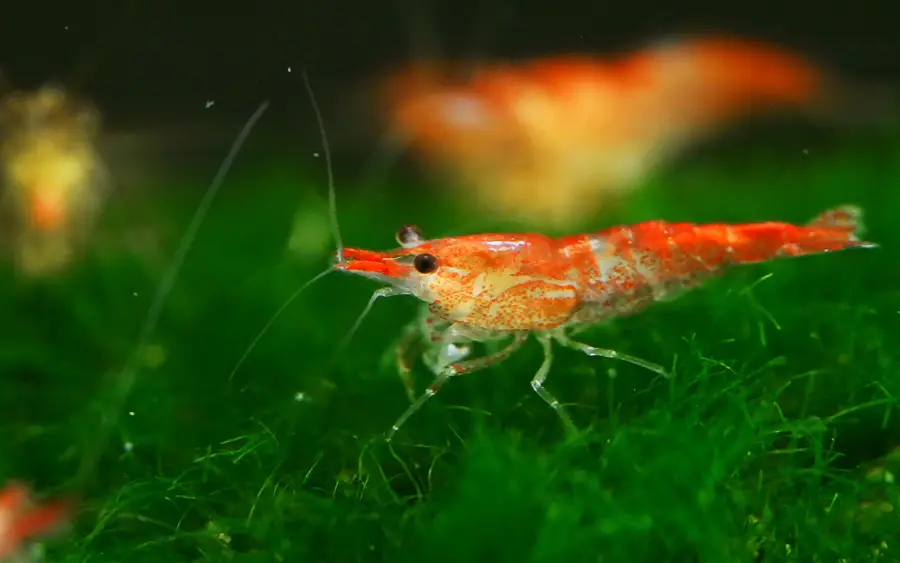
Monitoring these shrimp water parameters allows shrimp keepers to create a thriving environment for their cherry shrimp.
Moreover, maintaining stable parameters is essential for the successful molting of red cherry shrimp. Shrimp require specific calcium levels to strengthen their exoskeleton during molting. Fluctuating parameters can stress the shrimp, making them vulnerable to disease and reducing their lifespan.
Additionally, the presence of beneficial bacteria in the aquarium filter helps process waste, ensuring that the water remains clean.
For optimal health, it’s crucial to regularly test your water using reliable test kits to ensure that GH, KH, pH, and TDS levels remain within the recommended range. By adhering to these ideal water parameters, shrimp keepers can enjoy a vibrant and lively shrimp community.
Neocaridina General Tank Setup
Setting up a tank for Neocaridina shrimp requires careful consideration of various factors to create a suitable environment. A minimum tank size of 10 gallons is advisable to provide ample swimming space and establish a stable ecosystem.
The substrate should be soft and fine, allowing shrimp to graze on the surface and search for food. Aquatic plants, such as moss and floating plants, not only enhance the aesthetic appeal of the aquarium but also provide hiding places and grazing opportunities for baby shrimp.
Additionally, incorporating shrimp caves made from natural materials can help create a stress-free environment for the shrimp.
In terms of filtration, a sponge filter is an excellent choice as it allows for gentle water movement while preventing baby shrimp from being sucked into the filter. The tank should also be well-planted to offer shelter and a natural habitat for the shrimp.
Using driftwood or catappa leaves can contribute to the water’s beneficial properties while providing hiding spots. It’s also essential to position the filter and heater in a way that avoids strong currents, as cherry shrimp prefer calmer waters.
An appropriately set-up Neocaridina shrimp tank will not only look beautiful but will also promote the overall health and well-being of the shrimp.
What Are Common Challenges in Keeping Cherry Shrimp?
Keeping red cherry shrimp can be rewarding, but there are several common challenges that shrimp keepers may encounter. One of the most prevalent issues is maintaining stable water parameters.
Even slight fluctuations in neocaridina shrimp water temperature, pH, or hardness can stress the shrimp, leading to health problems or even death.
Additionally, shrimp are sensitive to water quality, and high levels of ammonia or nitrite can be detrimental. Regular water changes and careful monitoring of cherry shrimp parameters are essential to prevent such issues.
Another challenge faced by shrimp keepers is the presence of predatory tank mates. While some nano fish, like chili rasboras and tetras, can coexist peacefully with cherry shrimp, others may pose a threat.
Larger fish, crabs, or aggressive species may eat the shrimp, particularly the baby shrimp. Therefore, careful selection of tank mates is vital to ensure a harmonious community.
Lastly, shrimp keepers must also pay attention to feeding; overfeeding can lead to excess waste, which can deteriorate water quality. By addressing these common challenges, shrimp keepers can foster a healthy environment for their red cherry shrimp.
How to Set Up a Perfect Shrimp Tank for Neocaridina?
Creating the perfect shrimp tank for Neocaridina involves several crucial steps to ensure a healthy environment. First, select a suitable tank size, generally at least 10 gallons for a small colony, and prepare to cycle the tank before introducing any shrimp.
The substrate should be chosen carefully; a nutrient-rich substrate can support plant growth while also providing a food source for the shrimp. Adding aquatic plants like moss and Java fern can create a natural habitat and help maintain water parameters.
Next, consider filtration options. A sponge filter is ideal for shrimp tanks, as it provides gentle filtration while serving as a breeding ground for beneficial bacteria.
The filter should be positioned to minimize strong currents, which can stress the shrimp. Incorporating shrimp caves and plenty of hiding spots will give the shrimp a safe space to thrive.
Additionally, using catappa leaves can help soften the water and provide a source of food. Lastly, ensure that the tank is adequately lit and that the temperature is maintained between 22-26°C (72-79°F). Following these guidelines will help set up a perfect shrimp tank for your Neocaridina.
How to Maintain Water Parameters in a Planted Tank?
Maintaining water parameters in a planted tank is essential for the health of both aquatic plants and cherry shrimp. Regular testing of GH, KH, pH, and TDS is crucial to ensure that the cherry shrimp parameters remain stable.
Utilizing a reliable water testing kit can help track these parameters, allowing shrimp keepers to make adjustments as needed. Additionally, performing regular water changes, typically 10-20% weekly, will help maintain water quality by removing accumulated waste and replenishing essential minerals.
In a planted tank, the balance between plants and shrimp is vital. Healthy aquatic plants can help absorb excess nitrates, contributing to better water quality.
However, it’s important to avoid over-fertilizing, as this can lead to algae blooms that compete with shrimp for resources. Regularly trimming plants and removing dead leaves will also help keep the tank clean.
Using a good-quality filter will ensure that the water circulates properly, providing oxygen and keeping the shrimp tank clean. By maintaining these practices, shrimp keepers can ensure their planted tank remains a vibrant ecosystem.
What Are the Best Tank Mates for Red Cherry Shrimp?
Choosing the right tank mates for red cherry shrimp is crucial for their safety and well-being. Ideal companions include small, peaceful fish such as chili rasboras, nano fish, and some species of tetras.
These fish are generally non-aggressive and will not pose a threat to adult shrimp or baby shrimp. Additionally, snails can make excellent tank mates, as they help clean up uneaten food and algae, contributing to a balanced ecosystem.
However, it’s essential to avoid larger or more aggressive species that may eat the shrimp. Crabs and some predatory fish are not suitable tank mates, as they may target shrimp, particularly during molting when the shrimp are vulnerable.
Similarly, avoid any fish that are known to be fin nippers, as they could cause stress or harm. By carefully selecting compatible tank mates, shrimp keepers can create a harmonious environment where cherry shrimp can thrive alongside their aquatic companions.
Commonly Asked Questions about Water Parameters for Red Cherry Shrimp Aquarium (FAQs)
What are the ideal water parameters for neocaridina shrimp?
Neocaridina shrimp, like the Essential Red Cherry Shrimp (RCS), thrive in stable water parameters. Ideal conditions include a temperature of 20-26°C, pH between 6.5-7.5, and a KH and GH of 4-8 dGH. Maintaining these conditions will help ensure your shrimp are healthy and happy.
Can I use tap water for my freshwater shrimp tank?
Yes, you can use tap water for your freshwater shrimp tank, but it’s essential to treat it first. Tap water often contains chlorine and other chemicals that can harm your shrimp. Use a water conditioner, such as Seachem Prime, to remove these harmful substances before adding it to your tank.
How can I keep the water clean in a tank with dwarf shrimp?
To keep the water clean in a tank with dwarf shrimp, perform regular water changes (about 10-20% weekly), avoid overfeeding, and include live aquarium plants. Plants will help absorb excess nutrients, and a good filtration system will oxygenate and filter the water, reducing pollutants.
What do shrimp love to eat in their diet?
Shrimp love a varied diet that includes high-quality shrimp cuisine, blanched vegetables like zucchini, and occasional treats like catappa leaves and cholla wood. These foods not only provide nutrition but also promote healthy grazing habits and support the micro-organisms they scavenge.
How do I ensure proper spawning conditions for my red cherry shrimp?
To ensure proper spawning conditions for your neocaridina shrimp, maintain stable water parameters and provide hiding spots like plants and decorations. When females are ready to spawn, they will release pheromones to attract males, and you may find eggs underneath their tails, indicating successful breeding.
What happens if I cull my shrimp population?
Culling your shrimp population can lead to a healthier tank environment. Removing less colorful or weaker specimens helps maintain the genetic quality of your shrimp. This process ensures that only the best traits are passed on, contributing to a more vibrant and robust shrimp community.
Can I keep different shrimp species, like blue velvet and rili, in one tank?
Yes, you can keep different shrimp species such as blue velvet and rili in one tank, as long as their water tank parameters and care requirements match. However, be cautious about potential hybridization, which may lead to less colorful offspring.
How often should I feed my shrimp, and how much is too much?
Feed your shrimp once or twice a day, offering only as much food as they can consume in a few hours. Overfeeding can pollute the tank, leading to poor water quality. Monitor their eating habits and adjust the amount accordingly to keep the tank clean and healthy.
What are some featured products that can help with shrimp care?
Some featured products that can aid in shrimp care include high-quality shrimp cuisine like Repashy, water conditioners like Seachem Prime, and specialized filtration systems to oxygenate and keep the water clean. Additionally, incorporating microfauna and breeding supplements can enhance the shrimp’s diet and breeding success.
Conclusion
In conclusion, understanding and maintaining the essential water parameters for red cherry shrimp is a vital aspect of successful shrimp keeping. By providing suitable conditions, including appropriate GH, KH, pH, and TDS levels, along with a well-planned tank setup, shrimp keepers can create an ideal environment for these beautiful creatures. While challenges may arise, such as fluctuating Cherry Shrimp Water Parameters or selecting compatible tank mates, proactive management can lead to a thriving shrimp community. With the right knowledge and care, red cherry shrimp can flourish, adding vibrancy to any home aquarium.
Recent blog posts
- What Do Cherry Shrimp Eat: 7 Astonishing Foods They Crave!
- Cherry Shrimp with Eggs: 7 Quick Steps to Happy Hatchlings!
- What To Feed Ghost Shrimp? (5 Essential Health Boosters)
- Shrimp Breeding Tank 101 (Setup, Size, Mates & Requirements)
- Do Shrimp Shed Their Skeleton? 3 Surprising Facts About Molting!
- Why Are Ghost Shrimp So Cheap: (5 Astonishing Reasons)
- Keeping Shrimp as Pets: 5 Proven Hacks for Stunning Aquarium
- Easiest Shrimp to Keep: 5 Effortless Delights You’ll Adore!


